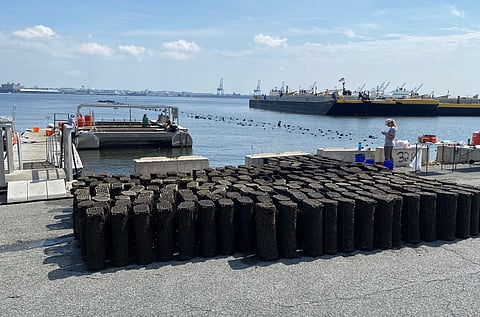

Another batch of solar-grown oysters is now up and running. With an astonishing 90% survival rate, the Solar Oysters and Chesapeake Bay Foundation (CBF) project on the expanding restoration reef off the coast of Fort Carroll, located on the Patapsco River south of Baltimore, is going from strength to strength.
Eight months ago, they initially placed the oysters, commonly referred to as spat, into the Solar Oyster Production System (SOPS), a solar-powered platform situated in the port of Baltimore.
During June, more than 356,600 oysters grown on the SOPS platform were moved and planted at Fort Carroll. Thus, again, this next batch of oysters is expected to thrive on the reef while contributing to improved water quality. The first group of young oysters was placed on the SOPS platform in October 2021 and transferred to the Fort Carroll restoration reef in November 2022.
"New technologies, such as SOPS, give us the ability to think innovatively and increase oyster production to help us achieve this goal," said Kellie Fiala, CBF's Oyster Restoration Coordinator. "Over the past two years, we were able to increase the numbers by more than 60% with this project."
SOPS uses clean energy through roof-mounted solar panels to drive the rotation of the oyster cages. Thus, the oysters move vertically along the water column, allowing them to access richer food sources and receive sunlight exposure when they are out of the water for specific periods, effectively reducing fouling. Compared to the traditional method of the area, the current compact design of the SOPS can produce up to 250,000 oysters in only a 0.02-acre space.
Oysters also play a vital role in improving water quality. They filter the water as they feed, removing excess nutrients and increasing water clarity. In addition, the reefs they form provide vital habitat for native fish species.
"This technology has the potential to shift the oyster aquaculture industry by reducing labor while producing healthy oysters for both restoration and consumption," said Emily Caffrey, SOPS platform manager. "The Solar Oyster Production System's automatic oyster cage rotation system dramatically increased oyster survival versus oysters sitting stationary. The more oysters that can be grown, the faster we can improve the bay's water quality, and oyster farmers will have more product to sell at market."
The Chesapeake Bay Foundation and Chesapeake Oyster Alliance have set a bold target. They want to introduce 10 billion oysters to the Bay by 2025 to preserve and restore this invaluable aquatic ecosystem.
Solar Oysters introduces a groundbreaking platform powered by solar energy for efficient oyster aquaculture. With the Solar Oysters Production System (SOPS), growers can expand capacity while reducing space requirements and labor demands. Originally focused on floating solar arrays, Solar Oysters collaborated with Maritime Applied Physics Corporation and a local power plant. Their goal is to develop a solution that not only harnesses renewable energy but also utilizes oysters.
Founded in 1966, the CBF actively dedicates itself as the largest independent conservation organization to saving the Chesapeake Bay. With a focus on science-based solutions, CBF fights against pollution and degradation, advocating for the restoration of the Bay. Through education, engagement with public leaders, and initiatives, CBF works tirelessly to preserve the health and biodiversity of this ecosystem.
